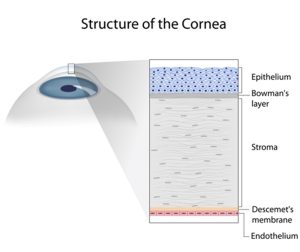Click here to resize type
Corneal Specialist in
West Palm Beach & Jupiter, FL
Cornea Overview
The eye’s cornea is a clear layer of tissue that protects some of the internal structures and helps to focus incoming light. Changes to the shape of the cornea can be detrimental to visual clarity.
Several conditions impact the health of the cornea. Keratitis is a painful infection that causes inflammation and can scar and otherwise damage the cornea. Treatments range from antibiotic eyedrops to corneal transplants in severe cases.

Corneal Dystrophies
A corneal dystrophy refers to a progressive condition — often inherited — in which the cornea loses its transparency due to a buildup of abnormal material. Two of the most prevalent are described below.
Fuch’s Corneal Dystrophy
The cornea has five primary layers. Fuchs’ dystrophy affects the endothelium layer, which is responsible for pumping fluid out of the central layers of the cornea. In this condition, endothelial cells die off, which can lead to corneal swelling and cloudy or hazy vision. Depending on the stage of the disease, vision may be blurry only upon waking in the morning (and slowly improving throughout the day) or persistently blurry all day.
Keratoconus
Keratoconus is the most common dystrophy. With this progressive condition, the cornea, which is usually round like a basketball, gradually thins and bulges into a more oblong shape like a football. This distortion interferes with the cornea’s focusing abilities and causes a decline in visual acuity. Severe cases of keratoconus can cause corneal scarring and require corneal transplant surgery.
Corneal crosslinking has been shown to delay the progression of keratoconus and possibly reduce or eliminate the need for more invasive treatment later on. During a corneal crosslinking treatment, the doctor administers a combination of riboflavin drops and ultraviolet light directly to the eye, which strengthens the collagen that holds the cornea together. By reinforcing the cornea, corneal crosslinking can stop or slow down the thinning and distortion that occurs with keratoconus.
Keratitis
Keratitis is an inflamed cornea. An eye with keratitis can feel irritated, experience blurry vision or light sensitivity and look red. Infectious keratitis is caused by the presence of bacteria, virus or fungi in the eye, while noninfectious keratitis can be caused by a scratch, dryness or allergies. The appropriate treatment for the condition generally depends on the root cause. People who wear contact lenses are most susceptible to keratitis because it is easier to get bacteria in the eye this way.
Pterygium
Pterygium is pinkish tissue that grows on the sclera and expands to the cornea. It is most often due to excess sun and wind exposure — common elements we experience in the West Palm Beach community. As pterygium gets bigger, it can begin to obstruct vision, but an ophthalmologist can remove the growth.
Dry Eye
Dry eye, also known as keratoconjunctivitis sicca, is an ocular surface disease that can be harmful to the cornea. Many cases occur when the meibomian glands in the eyelids are blocked and cannot function properly.
The eye’s tear film plays an important role in lubricating the eyes and promoting clear vision. The tear film is comprised of three layers: oil, water and mucus. The oily layer, which is produced by the meibomian glands, is responsible for helping tears “stick” to the ocular surface. If the glands become obstructed by thickened oil deposits, they cannot secrete oils into the tear film, and the tears evaporate too quickly. This condition is called evaporative dry eye.
Symptoms
Evaporative dry eye symptoms include the following:
- Burning or itching of the eyes
- Red eyes
- Sensitivity to light
- Blurry vision
- A “foreign body sensation” – i.e., the feeling of a piece of dirt or debris stuck in the eyes
Complications
A healthy tear film is important for ocular health. Severe cases of dry eye that are left untreated can lead to complications affecting the cornea. For example, a chronic lack of moisture can cause inflammation and ulcers to form on the cornea. Also, untreated dry eye can increase the risk of eye infections.
How to Schedule a Consultation
To learn more about the cornea and ways to treat and detect risks to its integrity, request a consultation at our West Palm Beach or Jupiter office by contacting Mittleman Eye today.
Cornea FAQs
Why is the cornea so important?

The cornea plays an essential role in sight because it refracts and focuses the light that enters the eye, which allows you to see. Beyond that, the cornea is an outer, transparent layer that protects the pupil and iris from debris and dust. It can withstand minor abrasions and repair itself.
How much does it cost to treat corneal conditions?
The cost of cornea care ultimately depends on the type of condition you have and the treatment you receive. Your medical insurance is likely to cover most types of cornea problems. If you are seeking care for dry eye, it is worthwhile to check your policy beforehand to see what exactly you are entitled to.
Mittleman Eye does offer financing options through CareCredit for patients who want to make payments toward their out-of-pocket expenses.
What is a cornea transplant?

Cornea transplant, also known as keratoplasty, is a serious surgery that replaces the patient’s damaged cornea with corneal tissue from a donor body. While most corneal transplants are successful at restoring vision, the recovery process from this surgery is significant: it can take over a year for full vision to be return. For that reason, corneal transplant is usually only suggested when other reasonable solutions have been ruled out.
Can I go blind due to a corneal condition?
Unfortunately, yes. Cornea conditions can impair your vision and, in extreme cases, even lead to complete blindness. According to the latest data, corneal blindness is the fourth leading cause of blindness in the world. (In the developed world, including the United States, it is significantly less likely thanks to the variety of treatments — including corneal transplant — available to handle these issues.)
Why is early detection so important for keratoconus?
While treatments like corneal crosslinking are highly effective at slowing and sometimes even halting the progression of keratoconus, it does not reverse the bulging of the eye. The sooner your doctor can diagnose and treat this debilitating eye condition, the more of your vision can be preserved. It makes sense to get a comprehensive eye examination at the first sign of trouble so you can undergo a non-invasive treatment like corneal cross-linking before keratoconus gets worse.
What happens if I ignore my dry eye symptoms?
Disregarding your dry eye symptoms is not a wise decision. What may currently feel like run-of-the-mill eye irritation can develop into more significant inflammation and impede the quality of your vision. Abrasions and corneal ulcers can also follow. Without proper moisture, your eyes are susceptible to infections.
















